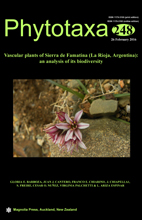Abstract
The Sierra de Famatina System is one of the main areas of endemism within the Southern Cone, as well as one of the main diversity hotspots of Argentina. We present here the first checklist for Sierra de Famatina, which includes 909 taxa (species, subspecies, varieties and forms) of vascular plants from 77 families and 358 genera. Sixty-eight are new records for La Rioja province and 28 are endemic species. Voucher specimens, locality information and distribution are given for each taxon, and a brief analysis of the diversity, phytogeography of the flora and the type specimens is presented. Illustrations of the important endemics and type specimens from Sierra de Famatina are provided. Our results emphasize the necessity to give high priority to the Sierra de Famatina region in terms of the conservation of its flora.

